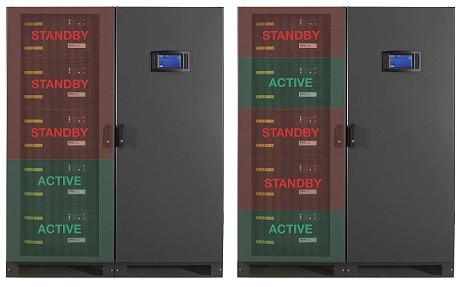Modular UPS technology, as implemented in systems such as KUP’s KOHLER PW 9500DPA, is now being exploited in a smart solution that maintains UPS efficiency even when the UPS load is severely reduced.
Loads in a converged or virtualised data centre environment can drop rapidly if servers are switched off-line in response to a reduced user demand. In other environments, the load may simply be lower than expected, or the contingency allowance may have been set too high. In any case, an unexpectedly low load can cause the upstream uninterruptible power supply (UPS) to operate significantly under capacity; a mode that can reduce its energy efficiency.
Xtra VFI mode, available on the KOHLER PW 9500DPA, solves this problem. The UPS is implemented in one to six racks, each containing up to five 100 kW modules. When enabled, Xtra VFI automatically adjusts the number of active modules to match the load requirement. Any that are not needed are switched to standby mode while remaining in a state of readiness, primed to transfer to active mode instantly if the load increases. The efficiency improvements achieved by this technique are especially significant if the load drops below 25% of the UPS system’s full capacity. An added benefit of Xtra VFI is that it rotates modules between active and standby, which extends the UPS’s service life.
The graph below shows how the Xtra VFI operating mode can enhance efficiency in a KOHLER PW 9500DPA UPS running at a low load level. The system has 10 UPS modules rated at 100 kW each, giving a total rated capacity of 1 MW.
Fig.1: How Xtra VFI improves UPS efficiency at low loads
Example (see Fig 2): Consider a load with a maximum requirement of 800 kW. This can be serviced by two 9500DPA frames, each populated with five 100 kW modules – providing 1000 kW, or 800 kW with N+2 redundancy.
If the actual load drops to 400 kW, the number of active modules will be reduced to four. This gives the UPS an active capacity of 400 kW, and a standby capacity of 600 kW.
The active modules all operate in double conversion mode, and share the load equally. The passive modules are in standby mode, with their inverters switched off, ready to transfer to active double conversion operation when the load increases.
This scaling of the active module capacity to track the load size maximises UPS efficiency. The system calculates the optimal capacity value for maximum efficiency, while allowing for the desired redundancy. The redundancy level for active capacity and the highest expected load step can be configured by the user to guarantee the highest protection level.
Xtra VFI is de-activated automatically if the mains fails or generates an alarm; all modules switch to ‘active’ status.
Fig 2: Example of how VFI mode works
UPSs running well below their rated load are frequently found in data centres, especially those where the load can change rapidly. Xtra VFI, together with modular UPS technology, eliminates this overcapacity. The result is improved energy efficiency, especially if the load has dropped to 25% or less of the UPS’s full capacity. Additionally, UPS service life is extended and aging is stabilised as Xtra VFI rotates modules between active and standby modes.








